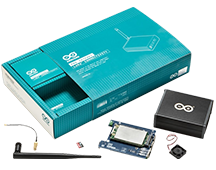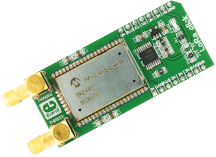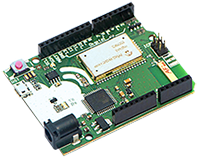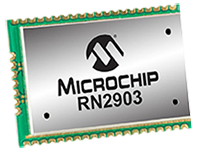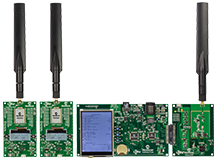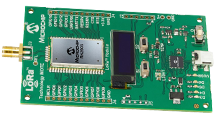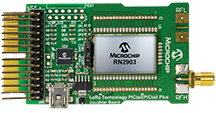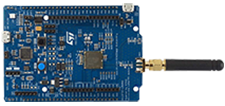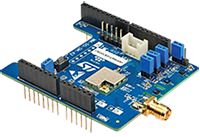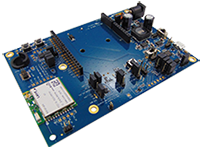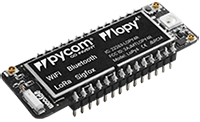IoT II: LoRaWAN for IoT Applications
Featuring: Arduino, Microelektronica, The Things Network, ST Microelectronics, Laird Technologies, & Pycom
If you are just getting started with LoRaWAN, the best way to do it is with an evaluation kit. What follows is a summary of some of the LoRa development boards, available from a variety of suppliers, that can be used to experiment with LoRa wireless connectivity, make your first LoRaWAN project, or design a new product with LoRa.
Arduino
If you are working with Arduino boards already, and are familiar with the Arduino Software (IDE) for code development and programming, then Arduino's MKR WAN 1300 is a great board to start experimenting with LoRa connectivity. It combines the functionality of the MKR Zero and LoRa connectivity. It's a convenient tool for makers who want to design IoT projects but don't have much experience with networking or LoRa connectivity. It's based on the Atmel SAMD21 and a Murata CMWX1ZZABZ Lo-Ra module.
The Arduino gateway kit provides LoRa (Long Range) connectivity using ultra-long range and high interference immunity on the 868 MHz radio bands. The gateway offers up to 8 LoRa Channels in the 868Mhz frequency allowing it to receive up to 8 LoRa packets simultaneously making it the ideal device to use in LoRaWAN gateway applications.
|
|
|
Microelektronica
Another quick way to build a LoRaWAN is with Microelektronika's click boards. The LoRa click carries Microchip's RN2483 fully certified LoRa Sub-GHz, 433/868 MHz European R&TTE Directive Assessed Radio Modem. It is designed to use either a 3.3V or a 5V power supply. It communicates with the target microcontroller over a UART interface (TXD, RXD, CTS) with the addition of a Reset pin (RST). The US version of the LoRa Click Shield can be found here.
To use the LoRa click board, you need a base board such as the EasyPIC V7EasyPIC V7 Development Kit or you can use the Raspberry Pi, where all you need is a Click Shield, which plugs into the Pi and the click board plugs into the Shield. Note: there are different versions of the Click Shield: Pi1 Click ShieldPi1 Click Shield, Pi2 Click Shield, and Pi3 Click Shield.
The Things Network
The Things Network has taken the world by storm with its community-based, public IoT networks based upon LoRa connectivity. What's nice about The Things Network is that the price of entry is low and there's a support network for you to get help and collaborate.
To participate in The Things Network, other than signing up, you need a Things node and a Things gateway. The Things Node is a based on the SparkFun Pro Micro and has an added Microchip LoRaWAN module along with an embedded antenna. It contains a temperature sensor, digital accelerometer, light sensor, button and RGB LED. All this is packaged in a matchbox sized waterproof casing.
To connect to the Things Network server, you'll need a Things Network Gateway/Base station that enables devices such as sensors and embedded computers to connect to the Internet.
If you want to use The Things Network to deploy your own IoT prototypes using LoRa connectivity, you should check out The Things Uno. You can use it to make one of your existing projects wireless up to 10km range by simply swapping your current Arduino board with the Things Uno.
The Things Uno is an Arduino Leonardo based embedded SBC solution with an integrated Microchip LoRaWAN (Long Range WAN) RN2483 module and on-board antenna. It is completely compatible with the Arduino IDE and Shields and can simply replace your current Arduino UNO board to add long range wireless capabilities to your projects. An optional external antenna can be added to maximize the range.
Microchip
Microchip's RN2903 Low-Power Long Range LoRa Technology Transceiver 915 MHZ module provides an easy to use, low-power solution for long range wireless data Transmission for North America. The RN2903 module complies with the LoRaWAN Class A protocol specifications. It integrates RF, a baseband controller, command Application Programming Interface (API) processor, making it a complete long range solution. The RN2903 module is suitable for simple long range sensor applications with external host MCU.
In Europe, the equivalent LoRa module is the RN2483A-I/RM103 Low-Power LoRa Technology TransceiverRN2483A-I/RM103 Low-Power LoRa Technology Transceiver, which works at 868 MHz.
If you are a professional user or a tech entrepreneur who would like a full set of building blocks to design a LoRaWAN from scratch, Microchip's LoRa Network Evaluation Kits should be at the top of your wish list.
The Microchip LoRa Technology Kit - 900 (NA version) includes an 8-Channel 915-MHz LoRaWAN Network Gateway along with 2 LoRaWAN motes and local LoRaWAN Network/Application Server. In other words, it contains everything necessary to setup a minimal LoRaWAN network. The package also comes with the Software Development Suite so that you can develop and deploy your prototype application. The Things Network has a great article on step-by-step setup of a test deployment.
The 915 MHz product range is applicable in the United States. The 900 Evaluation Kit discussed above works at 915 MHz. The RN 2903 module is the basis for the RN 2903 motes that are included for the 900 Evaluation kit. Additional motes or RN 2903 modules can be purchased to expand the capabilities of your test deployment. Standalone RN 2903 modules can be used in conjunction with a compatible PICtail/PICtail-Plus Board.
In Europe, the equivalent Evaluation kit is the Microchip LoRa Technology Evaluation KitLoRa Technology Evaluation Kit - 800, which works at 868 MHz. The RN 2483 product range of modules and motes is applicable in this band. Even though the evaluation kit is for the 868 MHz range, the RN 2483 Transceiver also works at the 433 MHz band.
The RN2903 LoRa Mote is a LoRaWAN
Class A end-device based on the RN2903 LoRa modem. As a standalone battery-powered node, the Mote provides a convenient platform to quickly demonstrate the long-range capabilities of the modem, as well as to verify inter-operability when connecting to LoRaWAN v1.0 compliant gateways and infrastructure.
The Mote includes light and temperature sensors to generate data, which are transmitted either on a fixed schedule or initiated by a button-press. An LCD display provides feedback on connection status, sensor values, and downlink data or acknowledgements. A standard USB interface is provided for connection to a host computer, providing a bridge to the UART interface of the RN2903 modem.
In Europe, the equivalent LoRa Mote is the RN2483 LoRa
MoteRN2483 LoRa
Mote, which works at 868 MHz.
The RN2903 LoRa Technology PICtail
/PICtail Plus Daughter Board is a development board for the Microchip RN2903 Low-Power Long Range, LoRa
Technology Transceiver Module.
Development of a LoRa system with the RN2903 connected to Microchip's PIC MCU line is possible on PIC18 Explorer boards via the 28-pin PICtail connector, or on Explorer 16 boards using the 30-pin card edge PICtail Plus connector.
The PICtail board also has an on-board PIC18 MCU available for custom user functions. It is pre-programmed to provide a simple USB-to-UART serial bridge enabling easy serial connection.
In Europe, the equivalent LoRa Technology PICtail
/PICtail Plus Daughter Board is the RN-2483-PICtailRN-2483-PICtail, which works at 868 MHz.
ST Microelectronics
Designed by ST Microelectronics The B-L072Z-LRWAN1B-L072Z-LRWAN1 is a low power wireless STM32L0 LoRa Discovery kit This kit is for LoRaWAN and LPWAN protocols with STM32L0 It is a development tool to learn and develop solutions based on LoRa and FSK/OOK technologies It features an all-in-one open module CMWX1ZZABZ-091(by Murata The module is powered by an STM32L072CZ and an SX1276 transceiver The transceiver features the LoRa long-range modem providing ultra long range spread spectrum communication and high interference immunity minimizing current consumption The LoRaWAN stack is certified class A and C compliant
If you are familiar with ST Microelectronics's Nucleo and Discovery evaluation platforms, then you may want to start your next LoRa-enabled IoT project with ST's Nucleo expansion board or the LoRa Discovery kit.
Called the LoRa expansion board for STM32 Nucleo (I-NUCLEO-LRWAN1), this third party board is an integrated solution allowing anyone to learn and develop solutions using LoRa
and/or FSK/OOK technologies. The I-NUCLEO-LRWAN1 features the USI
LoRaWAN
technology module, addressing low-power wide area network (LPWAN) and comes with embedded AT-commands stack pre-loaded. The I-NUCLEO-LRWAN1 can be controlled from an external host such as a NUCLEO-L053 board, running the I-CUBE-LRWAN embedded software. The I-NUCLEO-LRWAN1 is LoRaWAN
class A certified and sustains the class C.
Note: The I-NUCLEO-LRWAN1 is supplied by a third party not affiliated with ST. For the latest information, refer to the third party's GitHub page.
Laird Technologies
The RM191-SM is a LoRa/BLE module (915MHz LoRa for US/Canada) featuring smartBASIC. It offers a solution for long range enterprise IoT deployments. It combines Bluetooth v4.0 with LoRaWAN into one module. The module aggregates and transmits data from Bluetooth smart (BLE) devices and sensors over LoRa to gateways as far as 15Km (~10 miles) away. This bridges the personal area network to the wide area network. The RM191-SM is LoRa alliance and Bluetooth SIG certified and fully interoperable with any LoRaWAN adherent gateway.
Pycom
The LoPy4 is a quadruple bearer MicroPython-enabled development board (LoRa, Sigfox, WiFi, and Bluetooth). Using the Espressif chipset, the LoPy4 combines power, friendliness, and flexibility. It has a Semtech LoRa transceiver SX1276 with a LoRaWAN stack and is compliant to Class A and C devices.
*Trademark. Microchip is a trademark of Microchip Inc. Other logos, product and/or company names may be trademarks of their respective owners.




